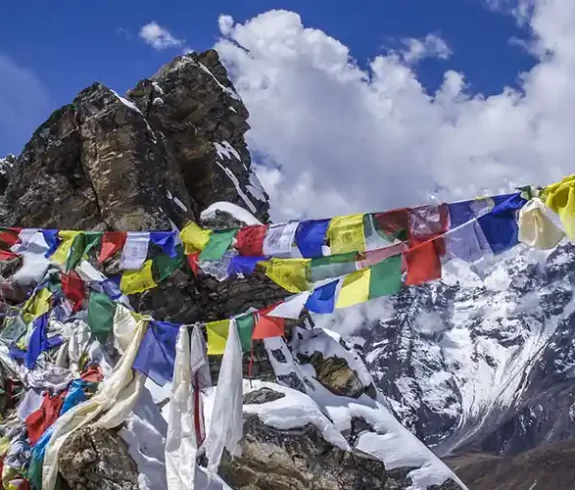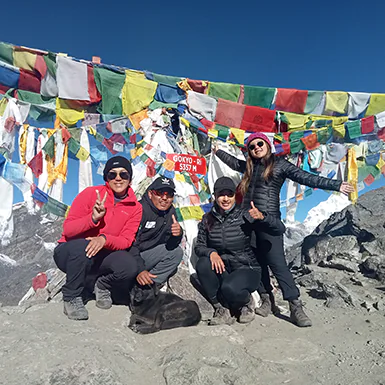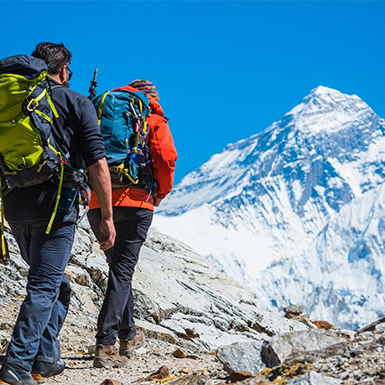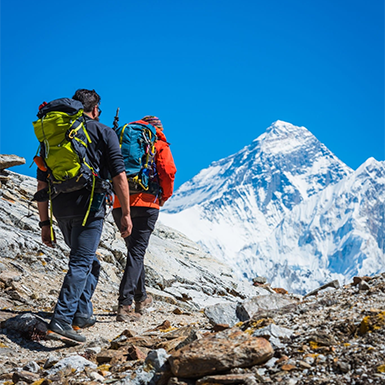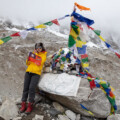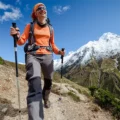In the heart of the Himalayas, Renjo La Pass awaits a testament to nature’s magnificence. This high-altitude pass, reaching a staggering 5,360 meters (17,585 feet), provides trekkers an extraordinary chance to behold the Everest region’s awe-inspiring beauty from a unique perspective.
This pass has become a favorite among those seeking a less-traveled path in the Everest area. Its appeal lies in the solitude and peace it offers, allowing trekkers to truly connect with the wild, untouched spirit of the Himalayas.
Why Trek Renjo La?
- Embrace Tranquility: Leave the crowds behind and find serenity on the Renjo La trek.
- Mountain Majesty: The pass reveals breathtaking 360-degree views of the world’s highest peaks, including Everest, Lhotse, Makalu, and Ama Dablam.
- Cultural Encounters: Trek through charming Sherpa villages, experiencing their rich culture and welcoming hospitality.
- A Rewarding Challenge: The trek to Renjo La offers a moderate to challenging adventure, perfect for experienced trekkers seeking something special.
- Landscapes in Flux: Traverse through vibrant rhododendron forests, glacial valleys, and high-altitude deserts, witnessing the ever-shifting beauty of the Himalayas.
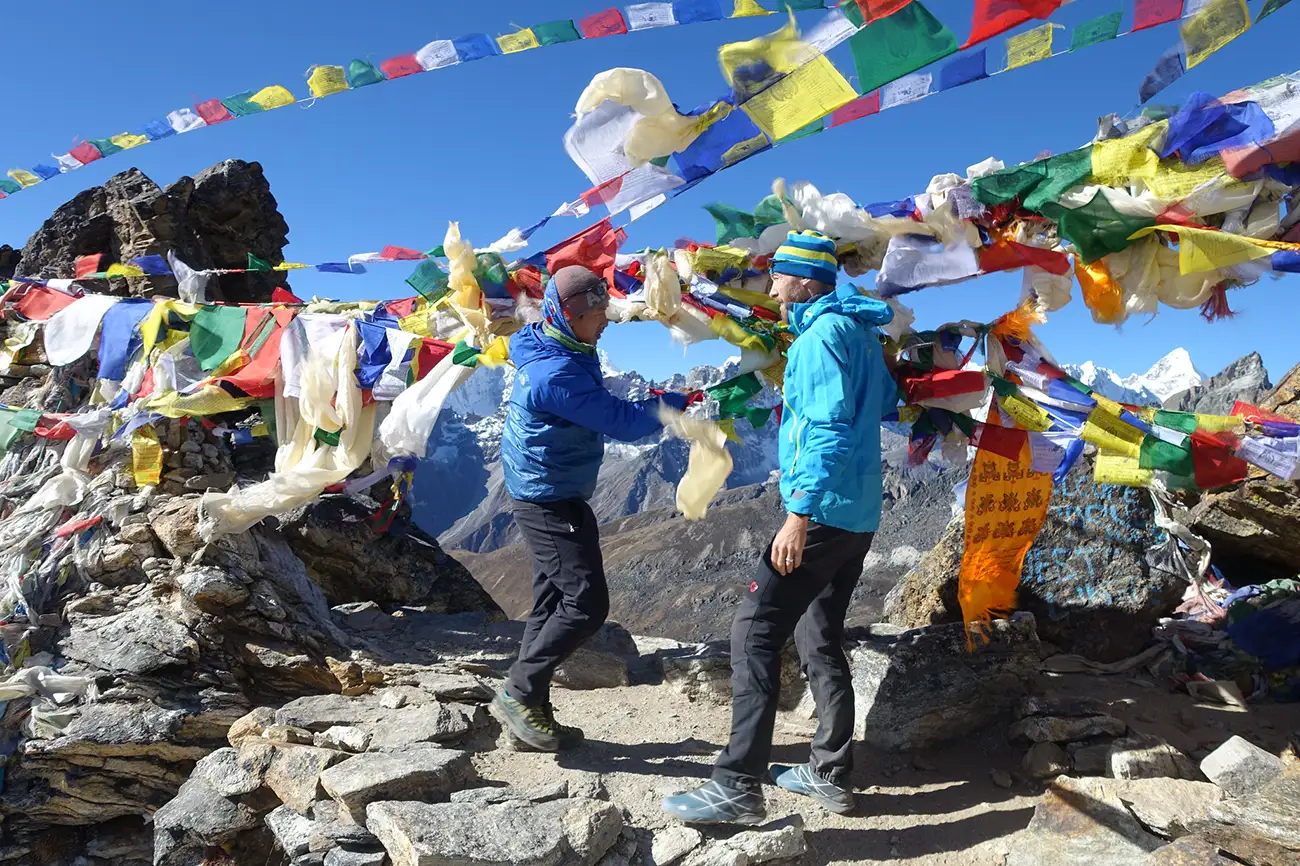
Exploring the Geography of Renjo La Pass: Where Mountains Meet the Sky
Trekkers seeking a challenge will find it at Renjo La Pass, a high-altitude pass in Nepal’s Solukhumbu district that connects the scenic Gokyo and Thame Valleys within the Everest region. The pass’s altitude of 5,360 meters (17,585 feet) promises breathtaking views and an unforgettable experience.
Surrounding Landscape
Neighboring Valleys:
- Gokyo Valley: West of the past, Gokyo Valley is famous for its pristine glacial lakes, including the mesmerizing Gokyo Lakes.
- Thame Valley: To the east, Thame Valley is dotted with traditional Sherpa villages, offering a glimpse into the local culture.
Majestic Peaks
- Everest (8,848 meters): The world’s tallest peak dominates the northern skyline, a breathtaking sight from the past.
- Lhotse (8,516 meters): The fourth-highest mountain globally stands proudly south of Everest.
- Makalu (8,463 meters): The fifth-highest peak adds to the eastern panorama.
- Ama Dablam (6,812 meters): Its unique pyramid shape graces the eastern horizon, captivating all who see it.
Navigating Renjo La
- Mapping Your Route: A reliable trekking map or guidebook is essential. It should clearly show the path to Renjo La and highlight key landmarks, campsites, and potential hazards.
- Trekking Options: Many include Renjo La in the Everest Three Passes Trek, also crossing Cho La and Kongma La. This challenging trek typically takes 12-14 days.
Challenges & Preparation
- Trekking Difficulty: The high altitude and unpredictable weather make this a challenging trek. Trekkers need to be physically fit and have high-altitude experience.
- Acclimatization is Key: Proper acclimatization is vital to prevent altitude sickness. To ensure proper acclimatization, plan for rest days between your trekking activities.
Trekking the Renjo La Pass: An Everest Region Adventure
The Everest Renjo La Pass Trek is a thrilling, high-altitude trek through some of the most spectacular scenery in the Himalayas. This challenging trek typically spans 12-14 days and offers a rewarding experience for seasoned trekkers seeking an off-the-beaten-path adventure.
Trekking Route and Highlights
- Starting Point: The trek often begins in Lukla, a small town accessible by a scenic flight from Kathmandu.
- Ending Point: After crossing Renjo La Pass, the trek typically concludes in Namche Bazaar, the bustling gateway to the Everest region.
Significant Stops
- Namche Bazaar: Acclimatize and explore this vibrant Sherpa town.
- Gokyo Lakes: Hike to these stunning glacial lakes and enjoy panoramic views.
- Gokyo Ri: Climb this peak for awe-inspiring vistas of Everest, Lhotse, Makalu, and Cho Oyu.
- Renjo La Pass (5,360 meters): The highlight of the trek is reaching Renjo La Pass, which offers breathtaking 360-degree views of the surrounding mountains.
- Thame Valley: Descend into this picturesque valley and experience Sherpa culture.
Experiences and Views
- Majestic Peaks: Throughout the trek, you will witness the awe-inspiring sight of Everest, Lhotse, Makalu, Cho Oyu, and numerous other peaks.
- Diverse Landscapes: Traverse through lush rhododendron forests, cross suspension bridges over roaring rivers, and trek across high-altitude deserts.
- Cultural Immersion: Encounter traditional Sherpa villages, visit ancient monasteries, and learn about the region’s unique culture.
- Wildlife Encounters: Look for Himalayan Thar, musk deer, and various bird species along the trail.
- Sense of Accomplishment: Crossing Renjo La Pass at 5,360 meters is a challenging feat that rewards trekkers with a profound sense of achievement.
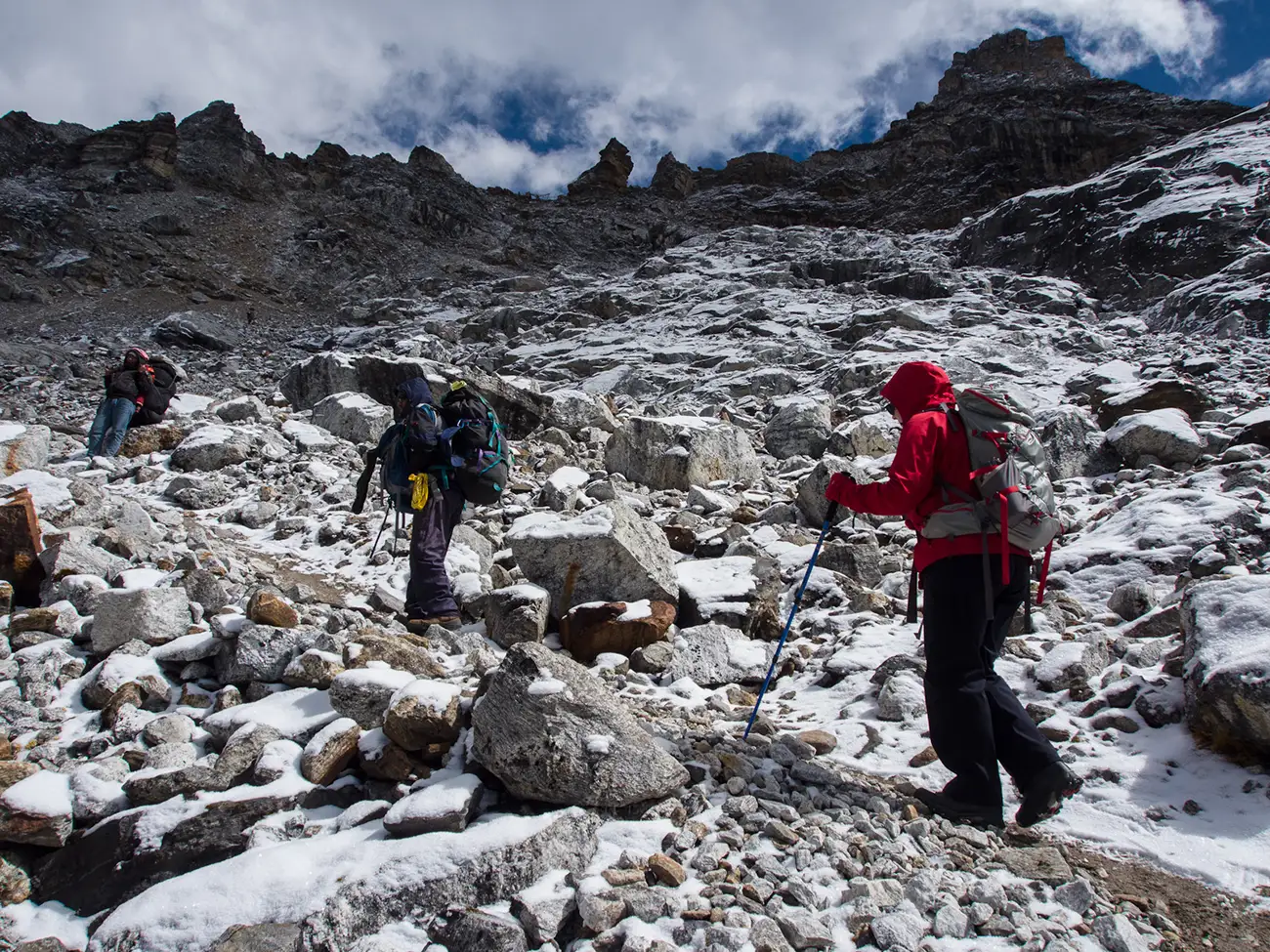
Charting Your Course: Navigating the Renjo La Pass
While the allure of the Renjo La Pass is undeniable, successful navigation requires careful planning and preparation. Understanding the route and potential obstacles is crucial for a safe and rewarding trekking experience.
Renjo La Pass Map and Waypoints
A detailed Renjo La pass map is an indispensable tool for safely and successfully navigating the challenging terrain of the trek. It should clearly outline the route, highlighting crucial waypoints, campsites, water sources, and potential hazards. Some key points to consider include:
- Lukla: Serving as the departure point for various trekking expeditions in the Everest region, including the challenging Renjo La Pass trek.
- Namche Bazaar: A bustling Sherpa town where trekkers acclimatize and prepare for the higher altitudes.
- Dole: A scenic village offering stunning views of the surrounding mountains.
- Machhermo: A high-altitude settlement known for its picturesque landscapes and yak pastures.
- Gokyo: A cluster of beautiful glacial lakes surrounded by towering peaks.
- Gokyo Ri: A viewpoint offering panoramic vistas of the Everest region.
- Renjo La Pass: The trek’s highest point, providing breathtaking 360-degree views.
- Lungden: A small village nestled in the Thame Valley.
- Thame: Thame, a traditional Sherpa village, boasts a rich cultural heritage that trekkers can experience firsthand.
- Namche Bazaar: The trek concludes in Namche Bazaar, allowing for further exploration or a return to Lukla.
Navigation Challenges and Solutions
- High Altitude: The Renjo La Pass trek reaches significant altitudes, posing a risk of altitude sickness. Acclimatize properly by including rest days in your itinerary and ascending gradually.
- Weather Conditions: Mountain weather is unpredictable and characterized by rapid changes in temperature, snowfall, or fog. It emphasizes the importance of proper attire, equipment, and potentially the expertise of a local guide.
- Trail Markings: While the main trails are generally well-marked, some sections may need clarification, especially in adverse weather conditions. Pay close attention to the map, landmarks, and cairns (stone piles) along the way.
- Route Finding: In case of doubt or challenging conditions, don’t hesitate to seek assistance from your guide, fellow trekkers, or local villagers.
- Physical Fitness: The Renjo La Pass trek requires good fitness and stamina. Train adequately before starting the trek, and listen to your body throughout the trek.
Conquering the Challenge: Renjo La Pass Difficulty and Preparation
Starting the Renjo La Pass trek is thrilling, but preparing well for the challenges is essential. Understanding the difficulty level and taking necessary precautions will ensure a safe and enjoyable experience.
Assessing the Renjo La Pass Difficulty
- Altitude: The Renjo La Pass altitude of 5,360 meters (17,585 feet) presents a formidable challenge to trekkers, adding to the allure and adventure of this high mountain pass. Trekkers must be mindful of the effects of high altitude, including altitude sickness. Proper acclimatization and gradual ascent are crucial.
- Terrain: The trek involves navigating steep ascents and descents, rocky trails, and potentially snow-covered or icy paths, particularly at higher elevations. Sturdy footwear and trekking poles are essential for maintaining balance and stability.
- Weather Conditions: Mountain weather is notoriously fickle, characterized by abrupt changes in temperature, powerful gusts of wind, and unexpected snowfall. During the trekking season, pack layers of clothing to adapt to varying conditions and prepare for potential delays due to weather.
Preparation and Gear
- Physical Fitness: The Renjo La Pass trek demands good physical fitness and stamina. In the months before your trip, engage in regular cardiovascular exercise, strength training, and hiking or trekking.
- Acclimatization: Plan your Renjo La Pass trek with sufficient rest days to allow your body to adapt to the decreasing oxygen levels. Stay hydrated, eat nutritious meals, and listen to your body.
Essential Gear: Pack the following essentials
- Sturdy trekking boots with good ankle support
- Waterproof and breathable jacket and pants
- Warm layers, including a fleece jacket, thermal base layers, and gloves
- Hat and sunglasses for sun protection
- Sunscreen and lip balm with high SPF
- Headlamp or flashlight for navigating in the dark
- First-aid kit with essential medications
- Water purification tablets or a water filter
- Keep your energy levels high with snacks and energy bars throughout your trek.
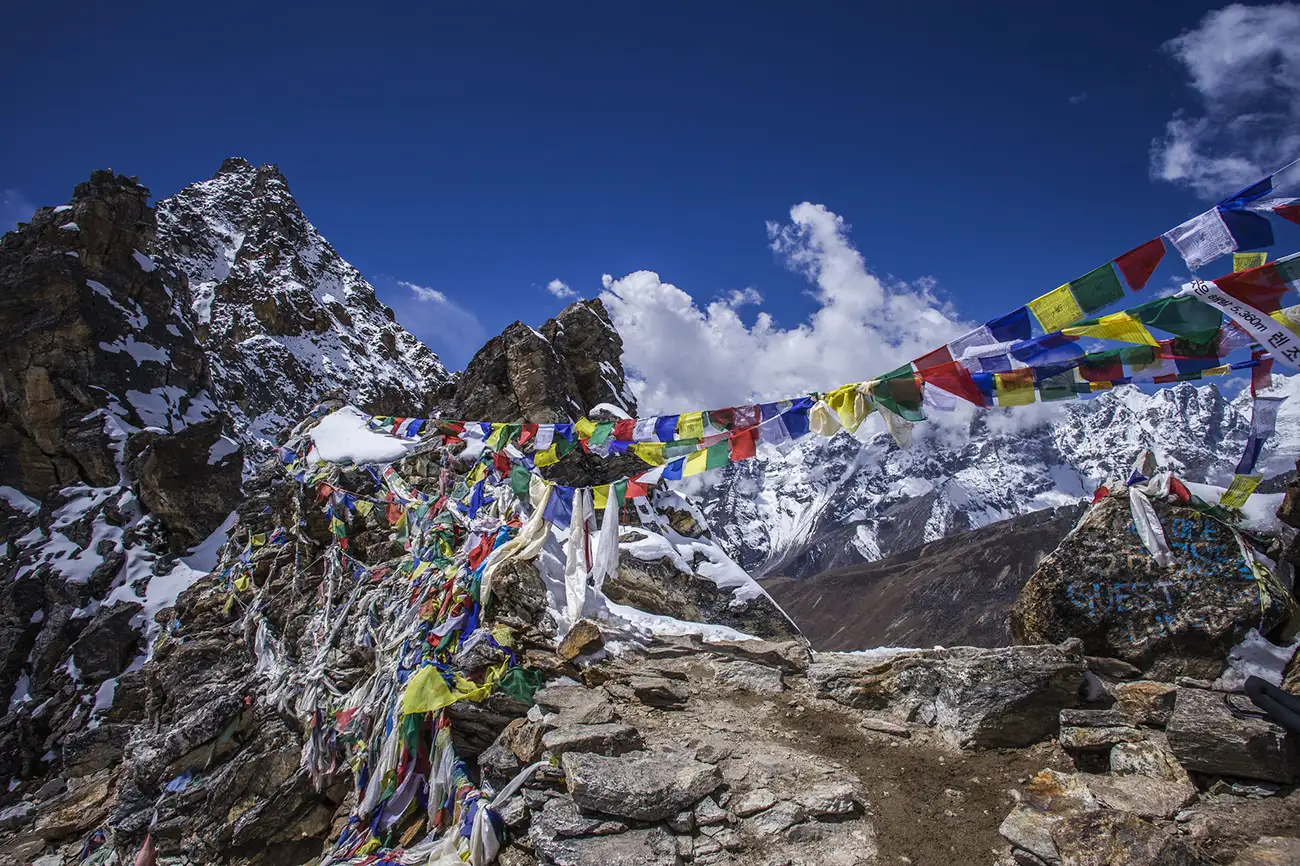
Renjo La Pass Itinerary: Day-by-Day Breakdown
Below is a sample Renjo La Pass itinerary that provides a detailed day-by-day breakdown of the trek. This itinerary includes recommendations for rest days, side trips, and cultural experiences in nearby villages.
Day 1-2: Arrival and Exploration in Kathmandu.
- Make your way to Kathmandu, the dynamic capital city of Nepal.
- Use this time to explore the city’s rich cultural heritage, visit ancient temples and stupas, and indulge in local cuisine.
Day 3: Scenic Flight to Lukla and Trek to Phakding (2,652m/8,700ft).
- Begin on a scenic flight to Lukla, the gateway to the Everest adventure.
- Begin your trek with a stroll to Phakding, following the winding Dudh Koshi River.
Day 4: Trek to Namche Bazaar (3,440m/11,286ft).
- Ascend through lush forests and cross suspension bridges as you make your way to Namche Bazaar, the central trading hub of the Khumbu region.
Day 5: Acclimatization in Namche Bazaar.
- Take a rest day to acclimatize to the higher altitude.
- Hike to the Everest View Hotel for panoramic views of Everest and surrounding peaks.
- Explore the Sherpa Museum and engage deeply with the local culture.
Day 6: Trek to Dole (4,200m/13,779ft).
Continue your ascent through rhododendrons and juniper forests, enjoying views of Ama Dablam.
Day 7: Trek to Machhermo (4,470m/14,665ft).
Hike through the picturesque Machhermo Valley, with views of Cho Oyu and Kangtega.
Day 8: Trek to Gokyo (4,790m/15,715ft).
Ascend to Gokyo, a collection of serene glacial lakes offering breathtaking scenery.
Day 9: Acclimatization and Exploration in Gokyo.
- Take a rest day to acclimatize further.
- Option to hike to Gokyo Ri (5,357m/17,575ft) for spectacular sunrise views of Everest, Lhotse, Makalu, and Cho Oyu.
- Explore the Ngozumpa Glacier, the largest glacier in Nepal.
Day 10: Trek to Lungden (4,380m/14,370ft) via Renjo La Pass (5,360m/17,585ft).
- The most challenging trek day is crossing the Renjo La Pass with its panoramic Himalayan views.
- Descend to Lungden for the night.
Day 11: Trek to Thame (3,800m/12,467ft).
- Descend further into the Thame Valley, known for its traditional Sherpa villages.
- Visit the Thame Monastery, an important Buddhist site.
Day 12: Trek to Namche Bazaar.
Return to Namche Bazaar, appreciating the well-known scenery in a fresh light.
Day 13: Trek to Lukla.
Descend back to Lukla, reflecting on the incredible trek you’ve completed.
Day 14: Fly back to Kathmandu.
Take a scenic flight back to Kathmandu and celebrate your successful trek.
Day 15: Departure.
Depart from Kathmandu or extend your trip to discover Nepal’s hidden gems.
Prioritize Safety: Trekking Smart on the Renjo La Pass
The Renjo La Pass trek is breathtaking, but safety should always be your top priority. Let’s explore how to stay safe and prepared while enjoying this high-altitude trek.
Safety Measures
- Acclimatize Wisely: Ascend gradually and take rest days to prevent altitude sickness. Listen to your body; if you experience symptoms, descend immediately.
- Stay Weather-Wise: Mountain weather changes quickly. Check forecasts, pack for all conditions, and be willing to adjust your plans if needed.
- Fuel Your Body: Stay hydrated and eat nutritious food to maintain energy and avoid altitude-related issues.
- Gear Up: Choose sturdy, waterproof boots with ankle support. Pack warm layers, rain gear, a first-aid kit, and any necessary medications.
- Trek with a Pro: Consider hiring a local guide, especially if you’re new to the area or high-altitude trekking. They offer expertise, navigation skills, and support in emergencies.
Emergency Preparedness
- Stay Connected: Carry a satellite phone or a reliable communication device. Let your trekking agency or lodge know your itinerary.
- Altitude Sickness Awareness: Know the symptoms (headache, nausea, dizziness, fatigue). Descend if symptoms worsen.
- Injury Response: Seek medical help immediately if injured. A first-aid kit is essential, but serious injuries may require evacuation.
- Evacuation Plan: You should provide travel insurance that covers helicopter evacuation in case of a medical emergency.
Healthcare Access
- Namche Bazaar: This town has a health post for basic medical needs.
- Lukla: The closest hospital with more comprehensive care is in Lukla.
- Kathmandu: Severe emergencies may require evacuation to Kathmandu for advanced treatment.
Best Trekking Seasons
- Spring (March-May): Clear skies, pleasant temperatures, and blooming rhododendrons make this a popular choice.
- Autumn (September-November): Another great option with stable weather, clear views, and colorful fall foliage.
Logistics and Planning
- Permits: Obtain a TIMS card and a Sagarmatha National Park entry permit.
- Local Guides: Hiring a guide enhances safety, offers cultural insights, and supports the local economy.
- Porters: Enhance your trekking experience by hiring a porter to handle your luggage.
- Accommodation: Tea houses along the trail offer basic lodging and meals. Book ahead during peak seasons.
Cultural Richness of the Renjo La Pass Trek: Embracing the Sherpa Way of Life
Beyond the awe-inspiring vistas and challenging trails, the Renjo La Pass trek offers a profound cultural experience. Experience the vibrant Sherpa way of life and witness the dedication to preserving this unique environment.
Cultural Encounters Along the Way
- Sherpa Villages: The trek winds through charming Sherpa villages like Namche Bazaar, Thame, and Khumjung. Connect with locals, experience their warm hospitality, and learn about their traditions.
- Monasteries: Discover ancient Buddhist monasteries like Tengboche and Thame. These spiritual hubs offer insight into the Sherpa’s deep faith and provide moments of peace amidst the mountains.
- Mani Walls and Prayer Flags: You’ll encounter vibrant mani walls and prayer flags covered in sacred mantras and symbols. These expressions of devotion are woven into the Sherpa landscape, offering a glimpse into their spiritual world.
- Festivals & Celebrations: If you’re lucky enough to trek during a festival, you might witness vibrant celebrations filled with traditional music, dance, and costumes, deepening your understanding of Sherpa culture.’
Environmental and Cultural Preservation
- Sagarmatha National Park: The Renjo La Pass trek lies within this UNESCO World Heritage site. Park authorities actively protect the delicate mountain ecosystem and its biodiversity.
- Sustainable Tourism: Local communities and trekking agencies champion responsible tourism. These efforts minimize trekking’s environmental impact, preserve cultural heritage, and empower local people.
- Waste Management: Initiatives promote proper waste disposal. Trekkers are encouraged to use reusable bottles, avoid single-use plastics, and pack out all trash.
- Cultural Sensitivity: Respect the local culture by dressing conservatively, seeking permission before photographing people or sacred places, and familiarizing yourself with essential Nepali phrases.
Tips for Respectful Cultural Engagement
- Learn About Sherpa Culture: Read about Sherpa customs and traditions before your trek to gain a deeper appreciation.
- Support Local Businesses: Discover unique treasures crafted by local artisans and experience authentic Nepalese flavors at local eateries.
- Minimize Your Impact: Avoid littering, stay on designated trails, and respect the wildlife.
- Engage Respectfully: Approach interactions with openness and curiosity, being mindful of cultural differences.
Renjo La Pass: A Himalayan Gem for the Adventurous
The Renjo La Pass trek is a hidden treasure within the Everest region, blending stunning scenery, cultural encounters, and a thrilling challenge. With proper planning and respect, this experience will leave a lasting impression on any seasoned trekker.
What Sets it Apart
- Escape the Crowds: Unlike the busy routes to Everest Base Camp, the Renjo La Pass offers a more peaceful, intimate connection with the mountains.
- Spectacular Vistas: When you reach the pass at 5,360 meters (17,585 ft), breathtaking 360-degree views of iconic peaks like Everest, Lhotse, Makalu, and Cho Oyu reward you.
- Diverse Himalayan Beauty: This trek showcases the full spectrum of the Himalayas’ charm, from lush valleys and glacial lakes to the stark beauty of high-altitude deserts.
- Cultural Connections: You will trek through traditional Sherpa villages, interact with friendly locals, and discover ancient monasteries.
Preparation is Key
- Get in Shape: This challenging trek demands good physical fitness and some prior high-altitude experience. Train with cardio and strength exercises months in advance.
- Acclimatize Smartly: Schedule rest days to acclimatize and prevent altitude sickness.
- Pack the Essentials: Choose gear suited to the weather, terrain, and altitude. Sturdy boots, warm layers, rain gear, and a first-aid kit are must-haves.
- Travel Responsibly: Respect local customs, the environment, and the Sherpa community. Minimize your impact, be mindful of waste, and support local businesses.
